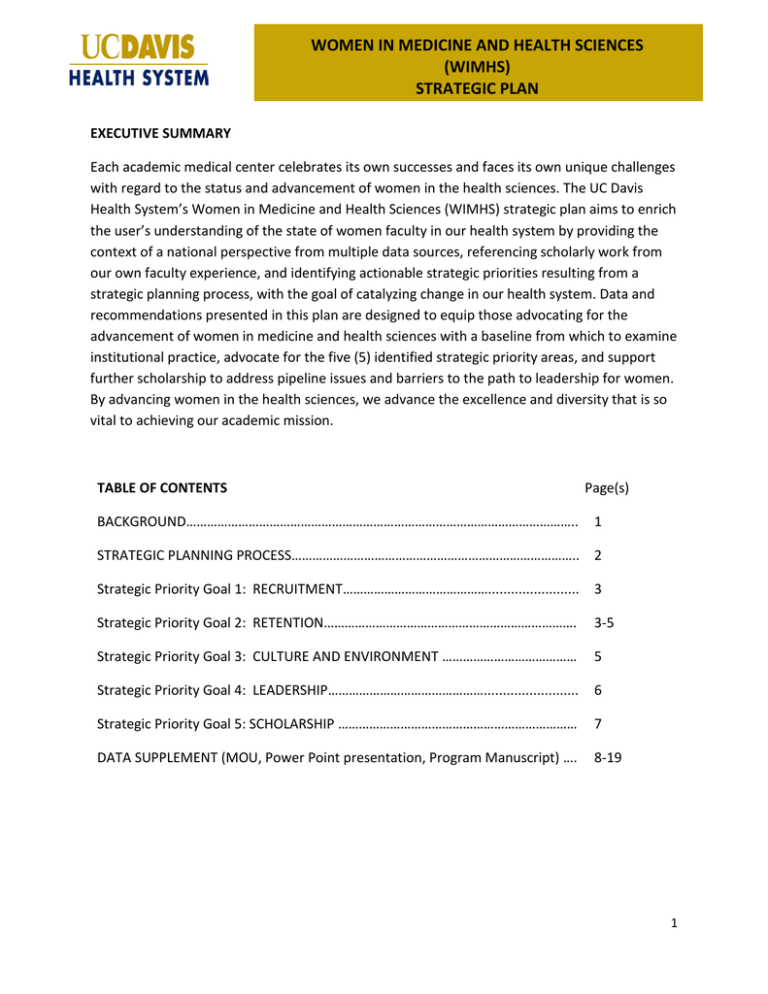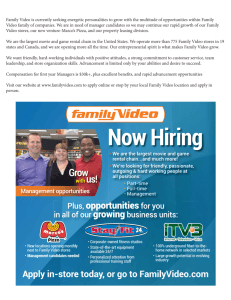WOMEN IN MEDICINE AND HEALTH SCIENCES (WIMHS) STRATEGIC PLAN
advertisement

WOMEN IN MEDICINE AND HEALTH SCIENCES (WIMHS) STRATEGIC PLAN EXECUTIVE SUMMARY Each academic medical center celebrates its own successes and faces its own unique challenges with regard to the status and advancement of women in the health sciences. The UC Davis Health System’s Women in Medicine and Health Sciences (WIMHS) strategic plan aims to enrich the user’s understanding of the state of women faculty in our health system by providing the context of a national perspective from multiple data sources, referencing scholarly work from our own faculty experience, and identifying actionable strategic priorities resulting from a strategic planning process, with the goal of catalyzing change in our health system. Data and recommendations presented in this plan are designed to equip those advocating for the advancement of women in medicine and health sciences with a baseline from which to examine institutional practice, advocate for the five (5) identified strategic priority areas, and support further scholarship to address pipeline issues and barriers to the path to leadership for women. By advancing women in the health sciences, we advance the excellence and diversity that is so vital to achieving our academic mission. TABLE OF CONTENTS BACKGROUND………………………………………………………………………………………………….. Page(s) 1 STRATEGIC PLANNING PROCESS……………………………………………………………………….. 2 Strategic Priority Goal 1: RECRUITMENT……………………………………........................ 3 Strategic Priority Goal 2: RETENTION………………………………………………………………. 3-5 Strategic Priority Goal 3: CULTURE AND ENVIRONMENT ………………………………… 5 Strategic Priority Goal 4: LEADERSHIP………………………………………......................... 6 Strategic Priority Goal 5: SCHOLARSHIP …………………………………………………………… 7 DATA SUPPLEMENT (MOU, Power Point presentation, Program Manuscript) …. 8-19 1 BACKGROUND: Women are integral to academic excellence, diversity, and all missions of the UC Davis Health System. Yet, women face unique challenges in academia and experience attrition from the advancement pipeline. Dedicated strategies are needed to support the careers of women in biomedical science and medicine and ensure the success of women in all aspects of academic life. The Women in Medicine and Health Sciences (WIMHS) Program at the UC Davis Health System was created in 2000 to support the careers of women in academia (for additional history, past activities and accomplishments of the WIMHS program please refer to the recent manuscript published in Academic Medicine provided in the Data Supplement section). The position of WIMHS in our school has been recently formalized (please refer to MOU in Data Supplement) and the program charged with formulating a strategic plan and budget to help guide its future activities and programmatic expansion. The MISSION of UC Davis WIHMS Program is to ensure the full participation and success of women faculty and women in the biomedical training pipeline in all roles within academic medicine. The VISION for WIMHS is to become a national leader and model program in the support of women’s careers in biomedical sciences, within a broader institutional context of inclusion and faculty development, attain high institutional impact and value, and stem the leaky advancement pipeline for women. STRATEGIC PLANNING PROCESS: A strategic planning retreat was held on February, 2015 from 1-4 pm to solicit broad input and guidance in formulating the strategic plan for WIMHS. Desired outcomes for the retreat were to raise awareness of the attendees and through the plan about important issues facing women in biomedical sciences; develop strategic planning priorities for WIMH; identify actionable items; and discuss sustainability and capacity. The planning retreat consisted of a power point presentation that reviewed the following topics: national data on women’s careers/recruitment/advancement; the status of women in academic medicine; the casual factors in women’s attrition from the advancement pipeline; and barriers to advancement and options for career flexibility. The presentation was also informed by results of our NIH RO1 grant for our institution specific data. (For details, please refer to the power point presentation provided in the Data Supplement section). Small group breakout sessions ensued to address each of the strategic priority goal areas, followed by a group presentations and discussion to help prioritize and integrate the concepts. The planning retreat was attended by a diverse group of faculty including members of our Health System leadership team as follows: Robin Steinhorn, Amparo Villablanca, Veronica Martinez-Cerdeno, Ed Callahan, Sheryl Catz, Melissa Bauman, Shadi Aminololama-Shakeri, Lydia Howell, Adrienne Thompson, Sandhya Venugopal, Ulfat Shaikh, and David Acosta. STRATEGIC PLAN: The overarching GOAL of WIMHS is to support and encourage the advancement of women at all levels (student, resident, fellow, post-doctoral, and faculty) in the Schools of Medicine and Nursing to attain their full academic potential via mentorship, sponsorship, personal and professional development, leadership, innovation, inclusiveness, and 2 a welcoming and supportive institutional climate. Five (5) strategic priority goals were identified in the strategic planning process focused on recruitment, retention, culture and environment, leadership, and scholarship as follows: Strategic Priority Goal 1: RECRUITMENT - Become a AAMC Leader in the Recruitment (and Retention) Especially for Women at the Rank of Associate Professor and Higher. Issue: Under-representation persists for women Associate and Full Professors. Women are less likely to be hired at the ranks of Associate or Full Professor in the SOM, and this difference is reflected in the gender distribution across ranks in the School of Medicine. Impact: Increase women faculty (physicians and researchers) at mid-and later career stage to serve as mentors and potential leaders. (Dr. Robin Steinhorn; Dr. Amparo Villablanca; Dr. Veronica Martinez-Cerdeno) Strategies: 1. Advocate for personalized recruitments (precision recruitment): culture shift for who we want to hire a. Target approach to academic rank of recruitment b. Tailor recruitment to highlight both our academic and community advantages c. Focus on our family/personal life advantages for Assist Prof and focus on individual recruit’s life needs d. Focus on leadership advantages for Associate Prof and their mentoring experience to serve as mentors to others e. Attend to culture (understand candidate’s cultural needs based on their race/ethnicity and leverage our academic culture to emphasize what's special about UCD to attract high quality candidates) f. Help recruit visualize themselves at UCD g. Highlight that HSCP track is treated with respect at UCD vs other institutions 2. Leverage our academic culture – advertise/promote our diversity and make it apparent to recruits 3. Data Needs a. Women at high academic ranks b. Smaller pool overall at higher ranks- grow pool internally through retention/advancement of Assist Profs c. Bias literacy (https://www.aamc.org/initiatives/diversity/contact/) d. Important non-tangibles (compensation for women and recruitment packages) Strategic Priority Goal 2: RETENTION - Identify Vulnerable Groups of Women for Departure, Increase Access to Mentors, and Provide Guidance on the Advancement Process. 3 Issue: The percentages of men and women faculty hired is near parity at the Associate Professor level, but nearly 50% of new faculty hires leave within 5 years of hire. Rank is the primary driving force for advancement and separation in our SOM, with faculty being less likely to separate once they achieve the rank of Associate Professor, and still less likely at Full Professor. Impact: Reduce faculty turnover to retain talent, increase morale and satisfaction especially in units with low retention, minimize costs associated with re-recruitment. (Dr. Ed Callahan; Dr. Sheryl Catz; Dr. Melissa Bauman) Strategies: 1. Data needs: Improve data collection to identify vulnerable populations. a. Administer faculty surveys by gender, series, and rank to identify vulnerable populations b. Encourage performance of exit interviews c. Faculty forward data: encourage the SOM to collect every 3 yrs to help inform the recruitment process d. Obtain and track data regarding # of women faculty and # of women faculty participating in faculty development opportunities and training 2. Improve use of mentoring (WIMHS in conjunction with the Mentoring Academy) a. Increase use of mentoring and number of mentors per individual and encourage mentors across Dept. lines b. Increase peer mentoring (women focused) and personalize mentors to mentee needs c. Encourage training for mentors to recognize faculty burn-out early before faculty decides to leave d. Adopt mentoring teams for scientific careers and for work/life balance e. Increase faculty resilience and focus on how to grow resilience f. Develop close partnership between mentoring academy and WIMHS g. Encourage women to include unmet mentoring needs in the context of career goal discussions at annual evaluation meetings (to help facilitate connections with potential mentors) 3. Promotion process: provide guidance (WIMHS in conjunction with Academic Personnel) a. Increase education about the promotion process b. Make guidance more women specific (team science, recognize contributions by women faculty) c. Provide packet preparation advice (merits/promotions) d. Create a pool of advisors to advise Asst. and/or Assoc. level professors on merits & promotions 4 4. Accountability and Rewards a. Encourage information sharing and monitoring of Dept. rate of success and process for supporting women faculty by holding Dpts/Chairs accountable for retention b. Encourage providing incentives/rewards to chairs to achieve accountability (e.g, SOM contribution to Dpt’s faculty development fund) c. Recognize and reward efforts to promote and support the careers of women faculty (e.g., via a new Dean’s Excellence in ‘Talent Development’ Award) d. 5 yr. chair reviews and mid 5 yr. chair reviews should include # of faculty sponsored to attend Faculty development courses (internal programs and external programs such as ELAM/AAMC) e. Encourage support for mentors: academic advancement credit, showcasing the mentors when their mentees are successful, and increasing the visibility of the Mentoring Awards Strategic Priority Goal 3: CULTURE AND ENVIRONMENT - Enhance/Improve the Current Culture to Promote Women’s Careers. Issue: SOM faculty report multiple barriers to career satisfaction, use of career flexibility options, and inclusion that relate to culture, environment and unconscious biases. Impact: Improve career satisfaction among women faculty, minimize separations, increase engagement. (Dr. Shadi Aminololama-Shakeri; Dr. Lydia Howell; Dr. Adrienne Thompson) Strategies (to overcome barriers/raise awareness): a. Address barriers and improve bias literacy (consider bias disrupters such as creating a platform to celebrate accomplishments of women faculty -- e.g., on WIMHS Facebook)) b. Disseminate barrier data from our NIH grant findings c. Form a Steering Committee for WIMHS (role and function) i. Provide advice to SOM leadership on institutional policies and priorities (updates to existing policies and development of new policies) ii. Identify mechanisms to gather and disseminate data on women faculty at UCDHS, including data related to barriers iii. Create and implement an annual event with workshops/posters on career development and leadership, and that will showcase scholarly projects and achievements of women faculty at UC Davis Health System (Link to Strategic Priority Goal 4j) iv. Partner with Mentoring Academy, particularly focused on addressing gaps in programs for women at Assoc. professor rank and higher 5 v. Assist WIMHS leadership with implementing strategic priority goals Strategic Priority Goal 4: LEADERSHIP - Develop Navigation Roadmaps to Leadership Excellence for Women. Issue: The percentages of women faculty in top leadership positions in our Health System remains low compared to men and there are few perceived leadership advancement paths for women faculty. "Making Room" for women leaders requires system change, succession planning, and creating a pipeline and pathways to leadership. Impact: Increase pool of women role models for earlier career faculty, increase participation of women in leadership and team science, increase their visibility and voice, reduce isolation and improve sense of empowerment. (Dr. Sandhya Venugopal; Dr. Ulfat Shaikh; Dr. David Acosta) Strategies: Outcomes data a. Obtain data on outcomes of past SOM AAMC and ELAM fellows b. Educate stakeholders about our data and the culture changes needed c. Use exit interview data to help identify solutions (e.g.; did faculty member leave due to lack of leadership opportunities?) d. Use current leaders/chairs/deans/CEO as leadership models for others through structured interviews and showcasing their paths to leadership (WIMHS blog, WHIMS leadership conference, other formats) e. Encourage development of internal leadership succession plans so that women don’t have to leave the institution to attain leadership positions f. Highlight accomplishments of our women leaders on the WIMHS blog, Facebook site and other internal/external communications g. Make the case for women in leadership h. Hold a signature event: national and/or UC-wide Women in Health Sciences Leadership Conference/Congress sponsored by UCD SOM (Link to Strategic Priority Goal 3.c.iii) i. Showcase women leaders at UCD (CAMPOS scholars, BIMSON and SOM leadership, WIMHS, our past AAMC and ELAM fellows, Dpt Chairs, Chancellor, our AAMC GWIMS representatives) ii. Identify sponsors/partners for conference (including AAMC?) iii. Showcase UCDHS models of leadership excellence, resilience, sponsorship and mentoring via panel discussions iv. Increase visibility of our leaders and recognize their value added v. Poster presentations to encourage networking and broad participation vi. Keynote speaker: ? Janet Napolitano 6 Strategic Priority Goal 5: SCHOLARSHIP - Provide Advocacy/Seek Opportunities for Scholarly Contributions . Issue: The causal factors impacting women’s careers in biomedical sciences are becoming better understood, but there are continued knowledge gaps about effective interventions for stemming attrition. Impact: Opportunities for funding, advocacy, and scholarship. 1. Identify NIH and other funding opportunities (e.g., RO1 Diversity and/or Sex Differences research supplements; K mentoring awards; RWJ; T32; others) 2. Explore opportunities to more broadly integrate WIMHS activities with women’s health/women’s health research issues 3. Support women’s participation in team science and encourage direct support of women’s careers in science 7 SUPPLEMENTARY DATA 1. WIMHS PLANNING RETREAT POWER POINT PRESENTATION 2. WIMHS MANUSCRIPT Melissa D. Bauman, Lydia P. Howell, and Amparo C. Villablanca. Women in Academic Medicine and Health Sciences (WIMHS): Innovation and Change at the UC Davis School of Medicine. Academic Medicine, 2014; 89(11):1462-66 8 9 10 11 12 13 14 15 16 17 18 19


